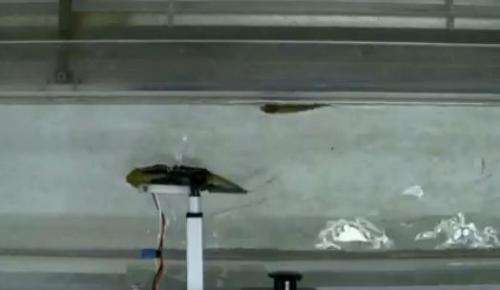February 24, 2012 report
Robot fish found able to lead real fish (w/ video)

(PhysOrg.com) -- Researchers studying schooling in fish have discovered that a real fish will follow a robot fish if it will help them use less energy swimming. This is the conclusion of a pair of engineers from New York’s Polytechnic Institute who built a small robot fish, as they describe in their paper published in the Journal of the Royal Society Interface, that other fish would follow in a controlled environment.
Very little is known about the mechanism involved when fish form schools, other than that they likely do it to make mating easier, to conserve energy and to ward off predators. All of these activities are offset by the increased competition for food and the problems associated with communicable diseases. To help understand what causes fish to form a school, Stefano Marras and Maurizio Porfiri built a small robotic fish that they attached to the bottom of an artificial channel of moving water in their lab. They then placed a live golden shiner fish in the water behind it to see what would happen (because the water was moving the fish had to swim just to stay even.) They found that if the robot fish didn’t move at all, the live fish tended to ignore it. But if they caused the tail on the robot fish to move in a way that is very similar to the way golden shiners move theirs, the live fish would move into formation behind it. And that wasn’t all, after moving into formation, the real fish slowed its movements slightly, indicating that by following the robot fish, it was gaining an energy advantage similar to the way geese do when they form a vee when flying.
The results of this experiment indicate that live fish can be led by a robot fish, which might prove useful in helping to protect fish populations at risk due to environmental disasters. But it also sheds light on possible motives for forming schools, namely that energy conservation is of utmost importance.
In the tank, the researchers noted that some of the fish appeared to be wary of their robot cousin, keeping their distance, even as they continued to swim in formation; most however, seemed to accept the robot into their school as easily as they would a real fish, despite the fact that the robot fish was not only covered with a plastic shell, but was twice as big as they were.
There remains, however, the question of why the fish were so easily able to accept a robot as not just a school member, but a leader.
More information: Fish and robots swimming together: attraction towards the robot demands biomimetic locomotion, J. R. Soc. Interface, Published online before print February 22, 2012, doi: 10.1098/rsif.2012.0084
Abstract
The integration of biomimetic robots in a fish school may enable a better understanding of collective behaviour, offering a new experimental method to test group feedback in response to behavioural modulations of its ‘engineered’ member. Here, we analyse a robotic fish and individual golden shiners (Notemigonus crysoleucas) swimming together in a water tunnel at different flow velocities. We determine the positional preference of fish with respect to the robot, and we study the flow structure using a digital particle image velocimetry system. We find that biomimetic locomotion is a determinant of fish preference as fish are more attracted towards the robot when its tail is beating rather than when it is statically immersed in the water as a ‘dummy’. At specific conditions, the fish hold station behind the robot, which may be due to the hydrodynamic advantage obtained by swimming in the robot's wake. This work makes a compelling case for the need of biomimetic locomotion in promoting robot–animal interactions and it strengthens the hypothesis that biomimetic robots can be used to study and modulate collective animal behaviour.
Journal information: Journal of the Royal Society Interface
© 2011 PhysOrg.com

















